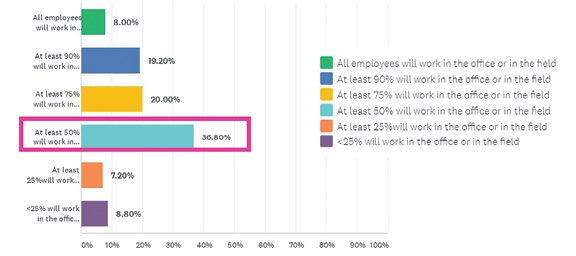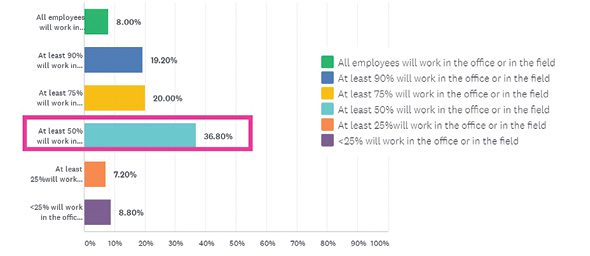Executive Corner: Don’t Neglect Post-Pandemic Employee Engagement

For this installment of “Executive Corner,” we explore how the A&E landscape has changed during the pandemic, particularly in terms of employees in a tight job market. Russ Ryan, principal at Rusk O’Brien Gido + Partners (email: [email protected]), interviews Bob Kelleher, founder of The Employee Engagement Group (email: [email protected]).

BOB KELLEHER
Ryan: Bob, you’ve been recognized as the thought leader in the A&E space on all things relating to the people part of the business, while also becoming the recognized thought leader in all industries in “employee engagement.” I think our readers would be fascinated by your background.
Kelleher: I’ve been in the A&E sector since 1985, where I joined Metcalf and Eddy in human resources. After becoming director of human resources, I joined ENSR in 1993, both as chief human resources officer (CHRO) and later as chief operating officer, and learned firsthand the importance of employee engagement as a key business driver.
During my years at ENSR, we were so early in this space that I acquired EmployeeEngagement.com as my personal website in the early 2000s (today the world’s most-visited engagement domain site). AECOM acquired ENSR in 2005, where I ultimately became their CHRO. In 2009, I left AECOM to write my first book, Louder Than Words—10 Practical Engagement Steps that DRIVE Results, which became a bestseller and led to founding The Employee Engagement Group, where today we work with organizations across the globe—both in and out of the A&E industry. I also host the A&E industry’s largest and oldest “people conference,” The AEC HR Summit.

AEC industry poll of 175 HR directors conducted by The Employee Engagement Group for the AEC 2021 HRemote Summit.
Ryan: We’ve been through a historic year. How has this impacted the A&E industry?
Kelleher: I’m a silver-lining type person and believe the events of the last 18 months will help shape the workforce of tomorrow in many positive ways. Three big changes occurred during the pandemic that are here to stay:
1. Telecommuting and the virtual employee will be the norm, not the exception. Although we will see a return to the office for many employees (and many have already returned to the office), you “can’t unscramble a scrambled egg.” Since the pandemic, leaders (especially chief financial officers) have seen the financial benefits of a reduced real estate footprint, while many employees have seen the benefits of working remotely.
For starters, they’ve learned they can be as productive (if not more so) working remotely. Employees also save on commuting time and costs, helping to better balance work/life commitments. That said, there will always be an “office” where employees receive a social benefit, interface with people and collaborate on projects.
I anticipate the new workplace to be a blend of those who return to the office full time (again, many already have), those who prefer to work remote, and the majority preferring a blended work week between home and office. The office of the past was where “work” got done. The office of the future will be where “culture” gets done. See the below graph of a recent poll I conducted of A&E HR directors asking what they envision will be the new workplace norm post pandemic:
2. The other big change we’re seeing is an increased focus in DEI (diversity, equity and inclusion). The social unrest of the last year elevated our need to build more diversity in the workforce (a long-overdue need in the A&E sector). The events during the last year highlighted the reality that we all have unconscious biases that can impact how and who we interact with, who we hire and promote, and decisions we make.
The equity component of DEI stands for fairness, rather than being equal—as recent events put a spotlight on how unfair society is with minorities. Traditionally in the A&E industry, diversity efforts were more compliance driven or perhaps a “nice to do” initiative. Going forward, we’re increasingly seeing DEI becoming a strategic initiative or a “must do” simply to compete. If you’re not focusing and investing in this important area, be aware, as your competitors are. See the graph (right) of another poll question I asked A&E HR directors on whether diversity has become a strategic initiative within their firms:

AEC industry poll of 175 HR directors conducted by The Employee Engagement Group for the AEC 2021 HRemote Summit.
3. The third big change we’ve seen is an increase in leadership empathy. During the last 18 months, I’ve witnessed more leaders exhibiting empathy and care than I experienced during the prior 30 years of my career. As we learned with Maslow’s hierarchy of needs, under duress, people focus on the basics of safety, health and security. In almost all examples of leaders I’ve worked with during the pandemic, leaders made decisions that were in the best interest of their employees’ well-being—even over the profitability of their firms. Sure, we still had layoffs, as organizations need to survive, but we saw a more-caring approach from leaders as they exhibited “employee-focused” traits. Leaders led with their hearts as much as their heads.
We also saw that organizations were rewarded with this concern for employees and their families, as many firms saw productivity gains above and beyond the norm. Research for my fourth book, I-Engage, Your Personal Engagement Roadmap, highlighted the connection between engagement and trust. When employees trust their leaders, engagement goes up. We also were able to make a connection that trust in leadership increases when employees believe their leaders care about them as people.
Although I wrote I-Engage in 2013, the last 18 months have been a case study in demonstrating that empathy and care can lead toward organizational success. I believe and hope this tendency will remain post-pandemic as leaders saw firsthand that care and empathy doesn’t mean “leading soft,” but actually builds employee goodwill—essential in building organizational-wide trust in leadership.
In the months ahead, I anticipate there will be “winners” and “non-winners” in the A&E industry, in particular as the “war for talent” resumes. Employees, for the most part, didn’t change jobs during the pandemic. This likely will change in the months ahead, and I believe this queued-up population—in addition to typical turnover—will impact your business more than you think.
Organizations that remain caring and empathic employers post-pandemic (it’s more intuitive to be caring during a pandemic) and/or those who become leaders in DEI and/or those who embrace the new blended workspace will have a significant strategic edge in engaging, retaining and acquiring new staff.


